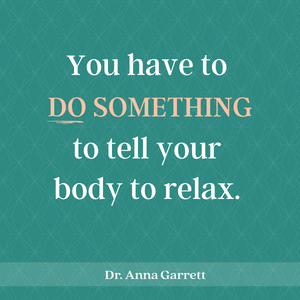Nervous System Support
We’ve spent the better part of this month talking about stress and its effects on hormone balance. Now, let’s talk about your nervous system.
You have 2 parts of your autonomic nervous system; the sympathetic and parasympathetic systems.
The sympathetic system intentionally downregulates GI function, detoxification systems, reproductive, and immune function under stress. It’s designed to kick in in short bursts, but when it becomes your primary way of showing up, there are some fundamental processes in the body that just don’t work well.
The body reacts exactly as it is designed to when you are always on high alert. As a result without managing stress, you may experience IBS, toxic buildup, brain fog, hormone imbalance, constant challenges with allergies and asthma, and an inability to shake off illnesses.
If you can become aware of the times you are operating in sympathetic mode (heart racing, ruminating, anxious, etc.) and choose to shift gears to activate the parasympathetic (rest and digest) nervous system mode, you will create better balance in the body. It is possible to purposefully choose stress management strategies that tell the nervous system that the battle is over and you are safe. But, it all starts in your head.
Is The Itty Bitty Shitty Committee Running the Show?
Stress management starts with your thinking. In other words, most of us have a running commentary in our heads from the “committee” that lives there. This committee never shuts up and is constantly judging and ruminating about anything, everything, and nothing.
And here’s the thing about all this “blah, blah, blah.” Your nervous system eavesdrops on every single thing that is going on. It’s paying attention to every single one of your fears, every judgment, everything that’s anxiety-producing or that you keep reliving. This keeps the sympathetic nervous system on high alert and your hormones like cortisol and adrenaline high.
“I’m Fine.”
You cannot fake out your body about the status of your stress. It doesn’t matter what kind of B.S. story you tell yourself about how great you are at handling stress. Above all, the reality on the inside is crystal clear to your nervous system and your hormonal axis and no amount of faking it will change how your body responds. I cannot count the number of clients I’ve had who told me they were “fine” when their symptoms and hormone testing painted a completely different picture.
Vavava Vagus!
Here’s where the rubber meets the road. The primary mechanism of parasympathetic activation in the human body is the vagus nerve. It’s the connection between the brain and the body. The vagus nerve connects our heart, lungs, ears, mouth, gut, and reproductive organs to the parasympathetic axis in our brain. People who struggle with poor parasympathetic tone often have issues with breathing, swallowing, nausea and vomiting, reflux, poor bowel function, and irregular menstrual cycles.
So, how do you love up your vagus nerve and increase the chances that you increasingly live in parasympathetic bliss? There are a number of ways to do this, all of which take minutes and are FREE.
Tips to Care For Your Vagus Nerve & Managing Stress
- Mindful breathing… box breathing using a 4-4-4-4 pattern is extremely helpful for calming you down quickly.
- Gratitude journaling… is a powerful practice when done with intention. It’s not enough just to list off 3-5 things you’re grateful for. Try getting into the WHY of your gratitude for a particular thing. For instance, I could say I’m grateful for the place I live. Which I most definitely am! But my why is because I can look out my windows and see mountains and a million different colors of green today. Look for the nuances that make the “thing” special.
- Gargling, singing, or humming… the vagus nerve is connected to your vocal cords and the muscles at the back of your throat. Singing, humming, chanting, and gargling can activate these muscles and stimulate your vagus nerve. And this has been shown to increase heart-rate variability and vagal tone.
- Surrounding yourself with beauty.
- Getting out in nature.
- Cold showers… researchers have also found that exposing yourself to cold on a regular basis can lower your sympathetic “fight or flight” response and increase parasympathetic activity through the vagus nerve. Try finishing your next shower with at least 30 seconds of cold water and see how you feel. Then work your way up to longer periods of time.
- Exercise.
- Laughing… improves heart rate variability (a marker of stress) and your mood.
- Self-massage.
Ending the Stress Cycle & Effectively Managing Stress
In their book, Burnout: The Secret to Unlocking the Stress Cycle, (which I highly recommend) Emily and Amelia Nagoski emphasize the importance of completing the stress cycle. It’s not possible to do this by just telling yourself all is well.
You have to DO something that gives your body the signal that it can relax. Many of the ideas above fulfill these criteria. Additional ideas include a good cry, creative expression, and a long hug or kiss.
 Your body will tell you when the cycle is completed. A shift in mood, mental state, or relaxation of tension in the body is all signs that the cycle has been completed. This may not be something that’s immediately recognizable if you’ve spent years accumulating stress cycles that are waiting to be completed. What’s important is that you notice that you feel incrementally better. As the stress in your body unwinds and the parasympathetic nervous system takes over, the body’s balance and health issues will begin to improve.
Your body will tell you when the cycle is completed. A shift in mood, mental state, or relaxation of tension in the body is all signs that the cycle has been completed. This may not be something that’s immediately recognizable if you’ve spent years accumulating stress cycles that are waiting to be completed. What’s important is that you notice that you feel incrementally better. As the stress in your body unwinds and the parasympathetic nervous system takes over, the body’s balance and health issues will begin to improve.
Dr. Anna Garrett is a menopause expert and Doctor of Pharmacy. She helps women who are struggling with symptoms of perimenopause and menopause find natural hormone balancing solutions so they can rock their mojo through midlife and beyond. Dr. Anna is the author of Perimenopause: The Savvy Sister’s Guide to Hormone Harmony. Order your copy at www.perimenopausebook.com.
Dr. Anna is available for 1-1 consultation. Find out more at www.drannagarrett.com/lets-talk




